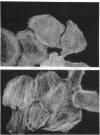Abstract
Cytotoxic necrotizing factor type 2 (CNF2) produced by Escherichia coli strains isolated from intestinal and extraintestinal infections is a dermonecrotic toxin of 110 kDa. We cloned the CNF2 gene from a large plasmid carried by an Escherichia coli strain isolated from a lamb with septicemia. Hydropathy analysis of the deduced amino acid sequence revealed a largely hydrophilic protein with two potential hydrophobic transmembrane domains. The N-terminal half of CNF2 showed striking homology (27% identity and 80% conserved residues) to the N-terminal portion of Pasteurella multocida toxin. Methylamine protection experiments and immunofluorescence studies suggested that CNF2 enters the cytosol of the target cell through an acidic compartment and induces the reorganization of actin into stress fibers. Since the formation of stress fibers in eukaryotic cells involves Rho proteins, we radiolabeled these small GTP-binding proteins from CNF2-treated and control cells with a Rho-specific ADP-ribosyltransferase. The [32P]ADP-ribosylated Rho proteins from CNF2-treated cells migrated slightly more slowly in SDS/PAGE than did the labeled proteins from the control cells. This shift in mobility of Rho proteins in SDS/PAGE was also observed when CNF2 and the RhoA protein were coexpressed in E. coli. We propose that Rho proteins are the targets of CNF2 in mammalian cells.
Full text
PDF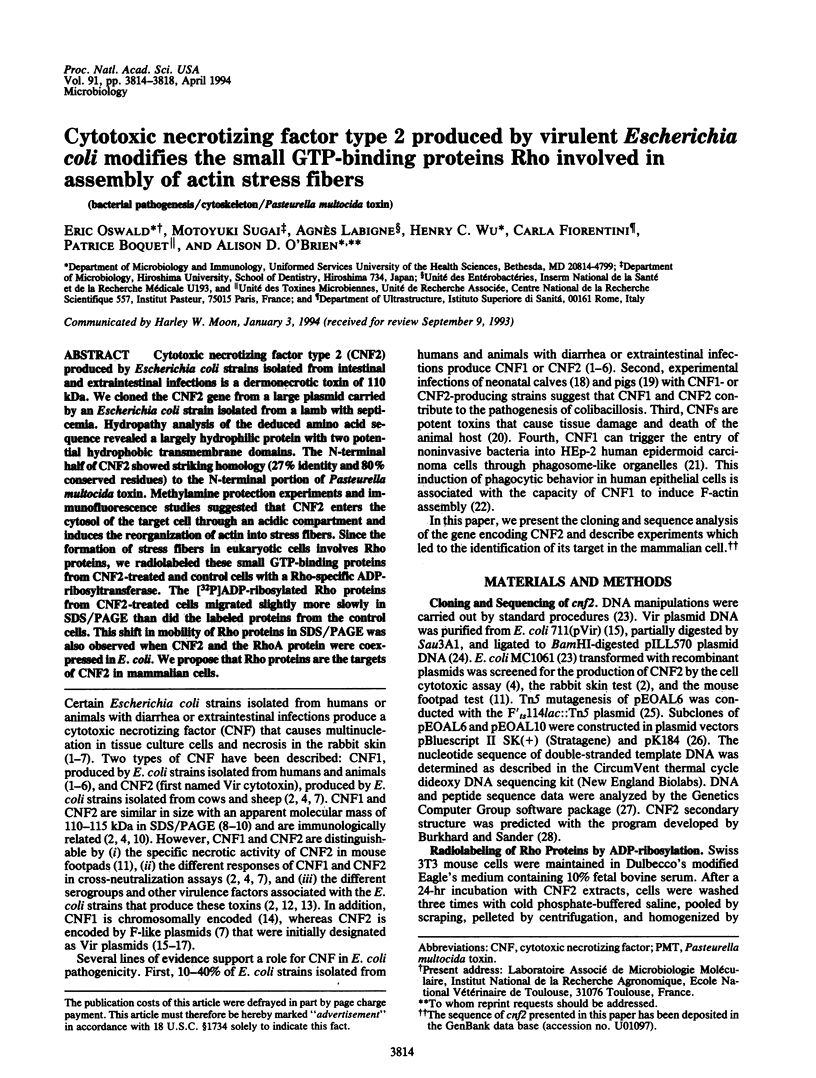
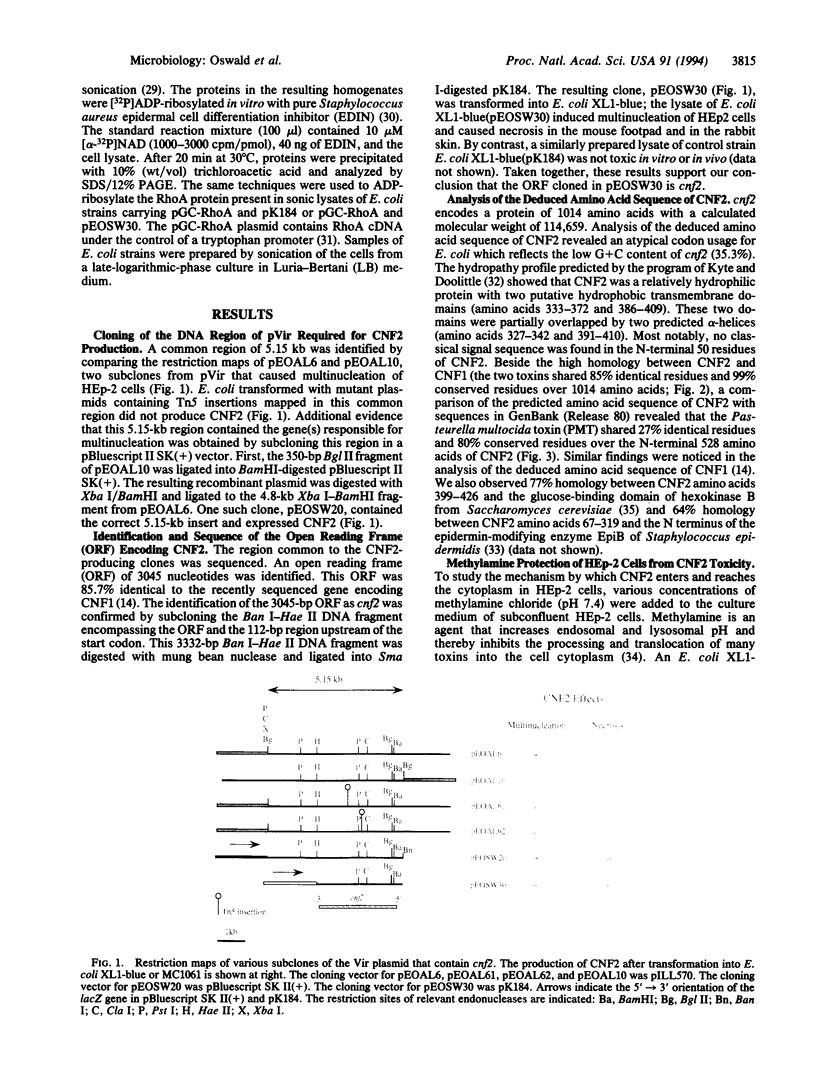
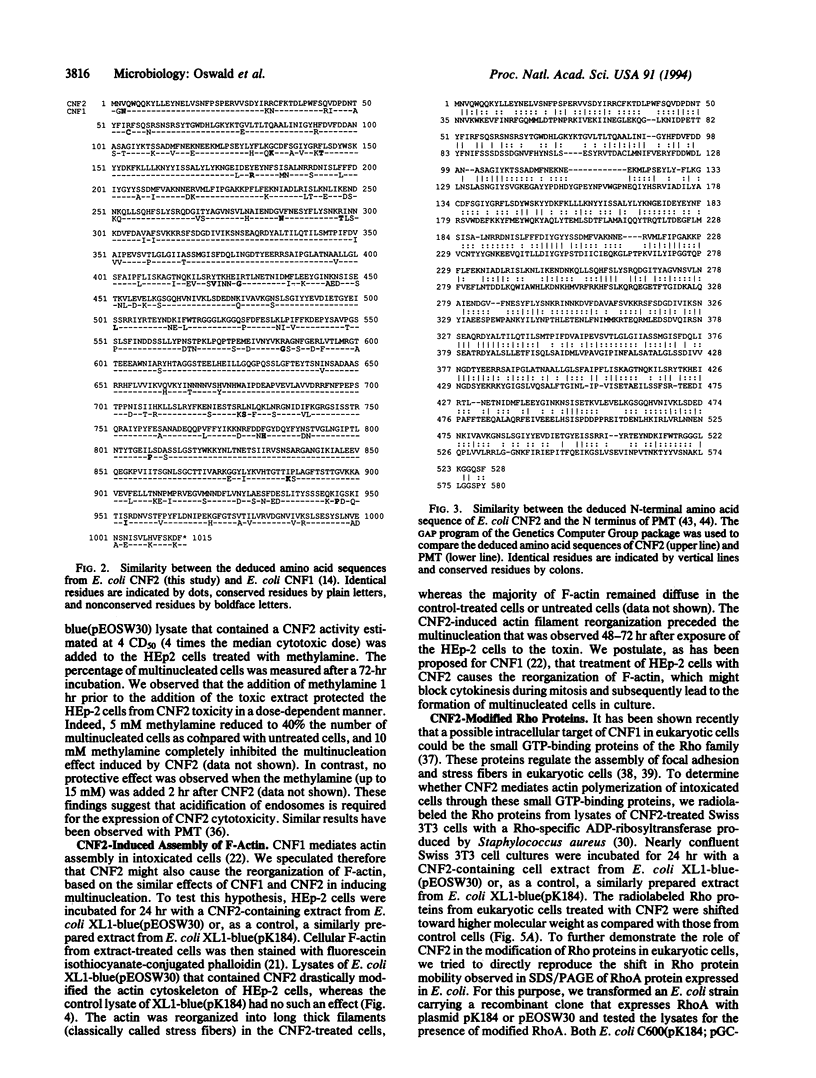
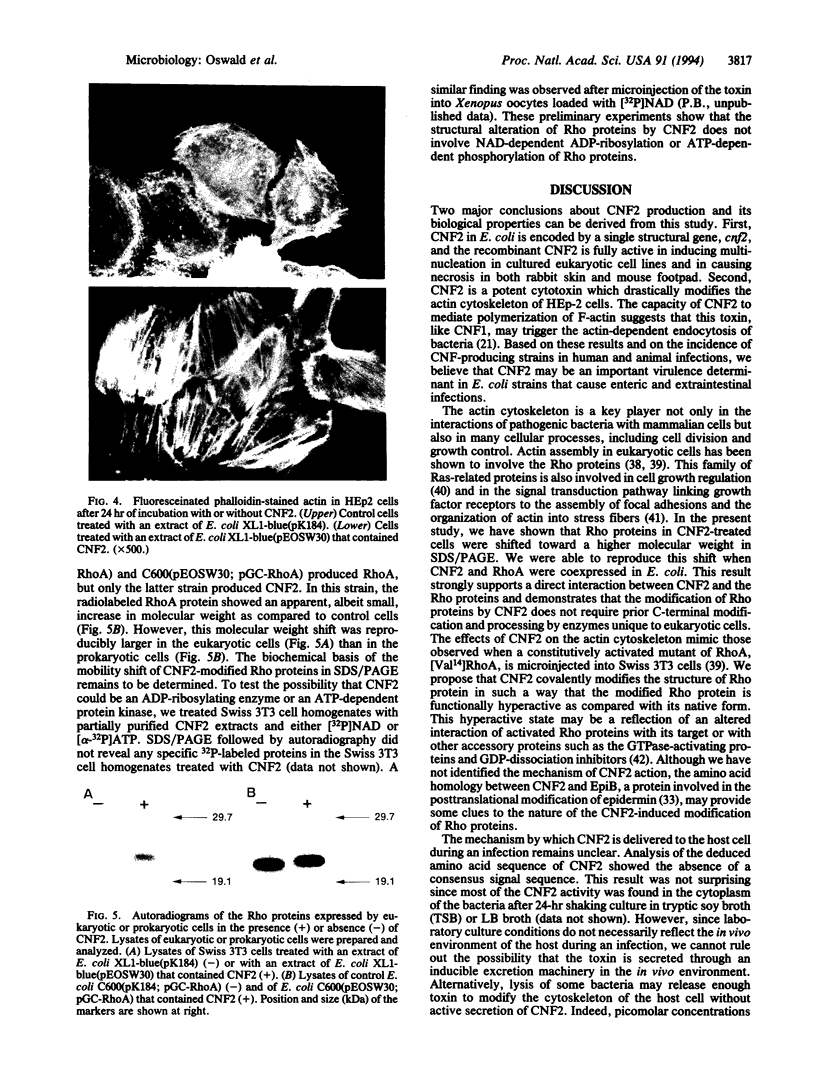
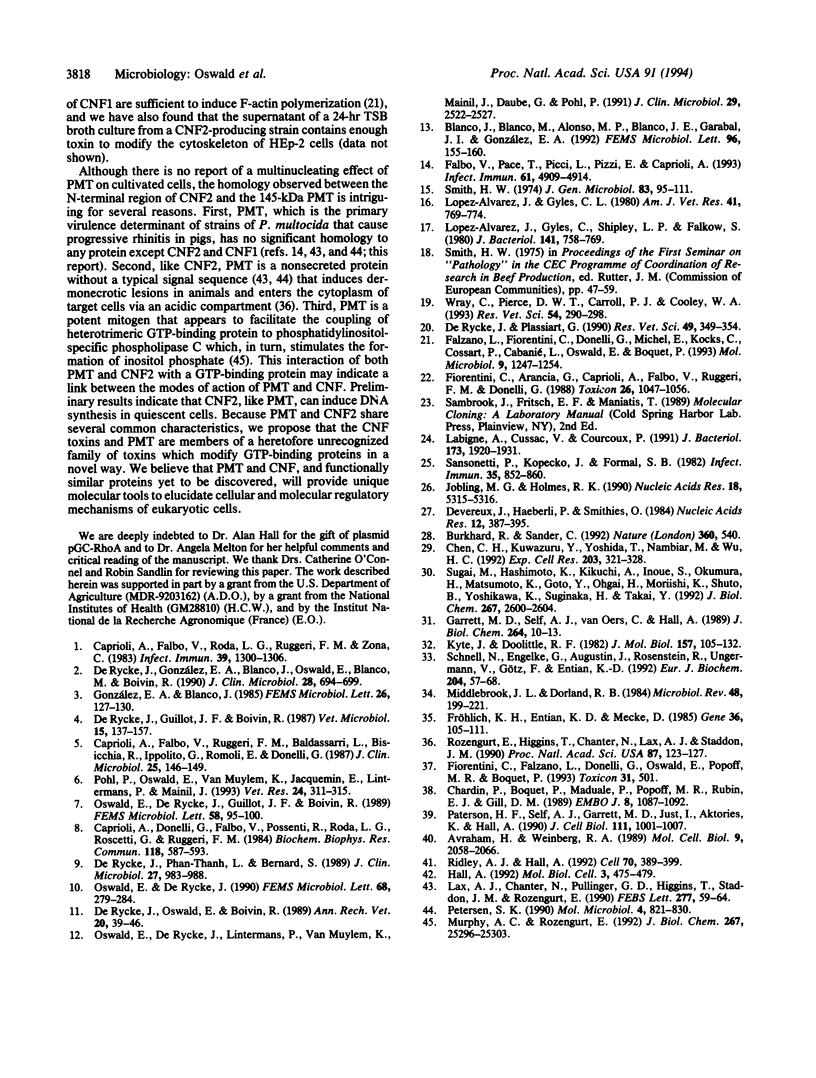
Images in this article
Selected References
These references are in PubMed. This may not be the complete list of references from this article.
- Avraham H., Weinberg R. A. Characterization and expression of the human rhoH12 gene product. Mol Cell Biol. 1989 May;9(5):2058–2066. doi: 10.1128/mcb.9.5.2058. [DOI] [PMC free article] [PubMed] [Google Scholar]
- Blanco J., Blanco M., Alonso M. P., Blanco J. E., Garabal J. I., González E. A. Serogroups of Escherichia coli strains producing cytotoxic necrotizing factors CNF1 and CNF2. FEMS Microbiol Lett. 1992 Sep 15;75(2-3):155–159. doi: 10.1016/0378-1097(92)90396-6. [DOI] [PubMed] [Google Scholar]
- Caprioli A., Donelli G., Falbo V., Possenti R., Roda L. G., Roscetti G., Ruggeri F. M. A cell division-active protein from E. coli. Biochem Biophys Res Commun. 1984 Jan 30;118(2):587–593. doi: 10.1016/0006-291x(84)91343-3. [DOI] [PubMed] [Google Scholar]
- Caprioli A., Falbo V., Roda L. G., Ruggeri F. M., Zona C. Partial purification and characterization of an escherichia coli toxic factor that induces morphological cell alterations. Infect Immun. 1983 Mar;39(3):1300–1306. doi: 10.1128/iai.39.3.1300-1306.1983. [DOI] [PMC free article] [PubMed] [Google Scholar]
- Caprioli A., Falbo V., Ruggeri F. M., Baldassarri L., Bisicchia R., Ippolito G., Romoli E., Donelli G. Cytotoxic necrotizing factor production by hemolytic strains of Escherichia coli causing extraintestinal infections. J Clin Microbiol. 1987 Jan;25(1):146–149. doi: 10.1128/jcm.25.1.146-149.1987. [DOI] [PMC free article] [PubMed] [Google Scholar]
- Chardin P., Boquet P., Madaule P., Popoff M. R., Rubin E. J., Gill D. M. The mammalian G protein rhoC is ADP-ribosylated by Clostridium botulinum exoenzyme C3 and affects actin microfilaments in Vero cells. EMBO J. 1989 Apr;8(4):1087–1092. doi: 10.1002/j.1460-2075.1989.tb03477.x. [DOI] [PMC free article] [PubMed] [Google Scholar]
- Chen C. H., Kuwazuru Y., Yoshida T., Nambiar M., Wu H. C. Isolation and characterization of a brefeldin A-resistant mutant of monkey kidney Vero cells. Exp Cell Res. 1992 Dec;203(2):321–328. doi: 10.1016/0014-4827(92)90005-s. [DOI] [PubMed] [Google Scholar]
- De Rycke J., González E. A., Blanco J., Oswald E., Blanco M., Boivin R. Evidence for two types of cytotoxic necrotizing factor in human and animal clinical isolates of Escherichia coli. J Clin Microbiol. 1990 Apr;28(4):694–699. doi: 10.1128/jcm.28.4.694-699.1990. [DOI] [PMC free article] [PubMed] [Google Scholar]
- De Rycke J., Guillot J. F., Boivin R. Cytotoxins in non-enterotoxigenic strains of Escherichia coli isolated from feces of diarrheic calves. Vet Microbiol. 1987 Oct;15(1-2):137–150. doi: 10.1016/0378-1135(87)90139-8. [DOI] [PubMed] [Google Scholar]
- De Rycke J., Oswald E., Boivin R. An in vivo assay for the detection of cytotoxic strains of Escherichia coli. Ann Rech Vet. 1989;20(1):39–46. [PubMed] [Google Scholar]
- De Rycke J., Phan-Thanh L., Bernard S. Immunochemical identification and biological characterization of cytotoxic necrotizing factor from Escherichia coli. J Clin Microbiol. 1989 May;27(5):983–988. doi: 10.1128/jcm.27.5.983-988.1989. [DOI] [PMC free article] [PubMed] [Google Scholar]
- De Rycke J., Plassiart G. Toxic effects for lambs of cytotoxic necrotising factor from Escherichia coli. Res Vet Sci. 1990 Nov;49(3):349–354. [PubMed] [Google Scholar]
- Devereux J., Haeberli P., Smithies O. A comprehensive set of sequence analysis programs for the VAX. Nucleic Acids Res. 1984 Jan 11;12(1 Pt 1):387–395. doi: 10.1093/nar/12.1part1.387. [DOI] [PMC free article] [PubMed] [Google Scholar]
- Falbo V., Pace T., Picci L., Pizzi E., Caprioli A. Isolation and nucleotide sequence of the gene encoding cytotoxic necrotizing factor 1 of Escherichia coli. Infect Immun. 1993 Nov;61(11):4909–4914. doi: 10.1128/iai.61.11.4909-4914.1993. [DOI] [PMC free article] [PubMed] [Google Scholar]
- Falzano L., Fiorentini C., Donelli G., Michel E., Kocks C., Cossart P., Cabanié L., Oswald E., Boquet P. Induction of phagocytic behaviour in human epithelial cells by Escherichia coli cytotoxic necrotizing factor type 1. Mol Microbiol. 1993 Sep;9(6):1247–1254. doi: 10.1111/j.1365-2958.1993.tb01254.x. [DOI] [PubMed] [Google Scholar]
- Fiorentini C., Arancia G., Caprioli A., Falbo V., Ruggeri F. M., Donelli G. Cytoskeletal changes induced in HEp-2 cells by the cytotoxic necrotizing factor of Escherichia coli. Toxicon. 1988;26(11):1047–1056. doi: 10.1016/0041-0101(88)90203-6. [DOI] [PubMed] [Google Scholar]
- Fröhlich K. U., Entian K. D., Mecke D. The primary structure of the yeast hexokinase PII gene (HXK2) which is responsible for glucose repression. Gene. 1985;36(1-2):105–111. doi: 10.1016/0378-1119(85)90074-5. [DOI] [PubMed] [Google Scholar]
- Garrett M. D., Self A. J., van Oers C., Hall A. Identification of distinct cytoplasmic targets for ras/R-ras and rho regulatory proteins. J Biol Chem. 1989 Jan 5;264(1):10–13. [PubMed] [Google Scholar]
- Hall A. Ras-related GTPases and the cytoskeleton. Mol Biol Cell. 1992 May;3(5):475–479. doi: 10.1091/mbc.3.5.475. [DOI] [PMC free article] [PubMed] [Google Scholar]
- Jobling M. G., Holmes R. K. Construction of vectors with the p15a replicon, kanamycin resistance, inducible lacZ alpha and pUC18 or pUC19 multiple cloning sites. Nucleic Acids Res. 1990 Sep 11;18(17):5315–5316. doi: 10.1093/nar/18.17.5315. [DOI] [PMC free article] [PubMed] [Google Scholar]
- Kyte J., Doolittle R. F. A simple method for displaying the hydropathic character of a protein. J Mol Biol. 1982 May 5;157(1):105–132. doi: 10.1016/0022-2836(82)90515-0. [DOI] [PubMed] [Google Scholar]
- Labigne A., Cussac V., Courcoux P. Shuttle cloning and nucleotide sequences of Helicobacter pylori genes responsible for urease activity. J Bacteriol. 1991 Mar;173(6):1920–1931. doi: 10.1128/jb.173.6.1920-1931.1991. [DOI] [PMC free article] [PubMed] [Google Scholar]
- Lax A. J., Chanter N., Pullinger G. D., Higgins T., Staddon J. M., Rozengurt E. Sequence analysis of the potent mitogenic toxin of Pasteurella multocida. FEBS Lett. 1990 Dec 17;277(1-2):59–64. doi: 10.1016/0014-5793(90)80809-w. [DOI] [PubMed] [Google Scholar]
- Lopez-Alvarez J., Gyles C. L. Occurrence of the vir plasmid among animal and human strains of invasive Escherichia coli. Am J Vet Res. 1980 May;41(5):769–774. [PubMed] [Google Scholar]
- Lopez-Alvarez J., Gyles C. L., Shipley P. L., Falkow S. Genetic and molecular characteristics of Vir plasmids of bovine septicemic Escherichia coli. J Bacteriol. 1980 Feb;141(2):758–769. doi: 10.1128/jb.141.2.758-769.1980. [DOI] [PMC free article] [PubMed] [Google Scholar]
- Middlebrook J. L., Dorland R. B. Bacterial toxins: cellular mechanisms of action. Microbiol Rev. 1984 Sep;48(3):199–221. doi: 10.1128/mr.48.3.199-221.1984. [DOI] [PMC free article] [PubMed] [Google Scholar]
- Murphy A. C., Rozengurt E. Pasteurella multocida toxin selectively facilitates phosphatidylinositol 4,5-bisphosphate hydrolysis by bombesin, vasopressin, and endothelin. Requirement for a functional G protein. J Biol Chem. 1992 Dec 15;267(35):25296–25303. [PubMed] [Google Scholar]
- Oswald E., De Rycke J. A single protein of 110 kDa is associated with the multinucleating and necrotizing activity coded by the Vir plasmid of Escherichia coli. FEMS Microbiol Lett. 1990 Mar 15;56(3):279–284. [PubMed] [Google Scholar]
- Oswald E., De Rycke J., Guillot J. F., Boivin R. Cytotoxic effect of multinucleation in HeLa cell cultures associated with the presence of Vir plasmid in Escherichia coli strains. FEMS Microbiol Lett. 1989 Mar;49(1):95–99. doi: 10.1016/0378-1097(89)90349-2. [DOI] [PubMed] [Google Scholar]
- Oswald E., de Rycke J., Lintermans P., van Muylem K., Mainil J., Daube G., Pohl P. Virulence factors associated with cytotoxic necrotizing factor type two in bovine diarrheic and septicemic strains of Escherichia coli. J Clin Microbiol. 1991 Nov;29(11):2522–2527. doi: 10.1128/jcm.29.11.2522-2527.1991. [DOI] [PMC free article] [PubMed] [Google Scholar]
- Paterson H. F., Self A. J., Garrett M. D., Just I., Aktories K., Hall A. Microinjection of recombinant p21rho induces rapid changes in cell morphology. J Cell Biol. 1990 Sep;111(3):1001–1007. doi: 10.1083/jcb.111.3.1001. [DOI] [PMC free article] [PubMed] [Google Scholar]
- Petersen S. K. The complete nucleotide sequence of the Pasteurella multocida toxin gene and evidence for a transcriptional repressor, TxaR. Mol Microbiol. 1990 May;4(5):821–830. doi: 10.1111/j.1365-2958.1990.tb00652.x. [DOI] [PubMed] [Google Scholar]
- Pohl P., Oswald E., Van Muylem K., Jacquemin E., Lintermans P., Mainil J. Escherichia coli producing CNF1 and CNF2 cytotoxins in animals with different disorders. Vet Res. 1993;24(4):311–315. [PubMed] [Google Scholar]
- Pérez Blanco F. J., Martín Ruíz J. L., Caballero Plasencia A., González Calvín J., Montero García M., Peña Angulo J. F. Test del ácido nicotínico y rifampicina en el síndrome de Gilbert. Rev Esp Enferm Apar Dig. 1985 Aug;68(2):127–130. [PubMed] [Google Scholar]
- Ridley A. J., Hall A. The small GTP-binding protein rho regulates the assembly of focal adhesions and actin stress fibers in response to growth factors. Cell. 1992 Aug 7;70(3):389–399. doi: 10.1016/0092-8674(92)90163-7. [DOI] [PubMed] [Google Scholar]
- Rost B., Sander C. Jury returns on structure prediction. Nature. 1992 Dec 10;360(6404):540–540. doi: 10.1038/360540b0. [DOI] [PubMed] [Google Scholar]
- Rozengurt E., Higgins T., Chanter N., Lax A. J., Staddon J. M. Pasteurella multocida toxin: potent mitogen for cultured fibroblasts. Proc Natl Acad Sci U S A. 1990 Jan;87(1):123–127. doi: 10.1073/pnas.87.1.123. [DOI] [PMC free article] [PubMed] [Google Scholar]
- Sansonetti P. J., Kopecko D. J., Formal S. B. Involvement of a plasmid in the invasive ability of Shigella flexneri. Infect Immun. 1982 Mar;35(3):852–860. doi: 10.1128/iai.35.3.852-860.1982. [DOI] [PMC free article] [PubMed] [Google Scholar]
- Schnell N., Engelke G., Augustin J., Rosenstein R., Ungermann V., Götz F., Entian K. D. Analysis of genes involved in the biosynthesis of lantibiotic epidermin. Eur J Biochem. 1992 Feb 15;204(1):57–68. doi: 10.1111/j.1432-1033.1992.tb16605.x. [DOI] [PubMed] [Google Scholar]
- Smith H. W. A search for transmissible pathogenic characters in invasive strains of Escherichia coli: the discovery of a plasmid-controlled toxin and a plasmid-controlled lethal character closely associated, or identical, with colicine V. J Gen Microbiol. 1974 Jul;83(0):95–111. doi: 10.1099/00221287-83-1-95. [DOI] [PubMed] [Google Scholar]
- Sugai M., Hashimoto K., Kikuchi A., Inoue S., Okumura H., Matsumoto K., Goto Y., Ohgai H., Moriishi K., Syuto B. Epidermal cell differentiation inhibitor ADP-ribosylates small GTP-binding proteins and induces hyperplasia of epidermis. J Biol Chem. 1992 Feb 5;267(4):2600–2604. [PubMed] [Google Scholar]
- Wray C., Piercy D. W., Carroll P. J., Cooley W. A. Experimental infection of neonatal pigs with CNF toxin-producing strains of Escherichia coli. Res Vet Sci. 1993 May;54(3):290–298. doi: 10.1016/0034-5288(93)90125-y. [DOI] [PubMed] [Google Scholar]




